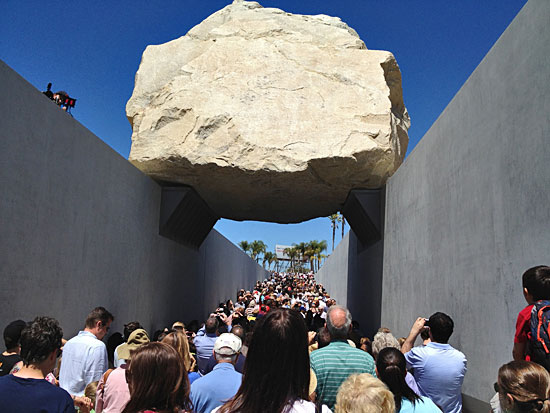With crowds, speeches, and even a rare appearance by its normally reclusive creator, Michael Heizer’s “Levitated Mass” finally opened on Sunday at the Los Angeles County Museum of Art.
“This is a monument to our own time and our own place and our own aspirations as people,” exulted LACMA Director Michael Govan, noting the months of public spectacle that accompanied the execution of the immense sculpture. “It does make the impossible possible.”
Surrounded by a geometric field of decomposed rock, the artwork—a 680,000-pound hunk of Riverside granite positioned atop a 456-foot-long concrete trench—basked in the L.A. sunshine. Birds perched on it. Palms swayed beside it. At one end, a Unocal billboard and a 99 Cent Store sign bedecked its horizon. Awestruck visitors gawked at the rock’s scale, called friends from beneath it and pretended to hoist it, creating, in the words of Curbed LA, an instant tradition of “boulder holding.”
Privately, Govan called it “an amazing, contemplative oasis in the middle of the busy metropolis.”
Heizer, dressed in a cowboy hat, cowboy boots and shades, had his own take as the crowd mobbed the Nevada earth artist, begging for autographs: “It isn’t a golf course, that’s for sure.”
Heizer conceived the sculpture 43 years ago, but didn’t complete it until he visited a granite quarry in Riverside County decades later and found the boulder that is its centerpiece. (Or, as Heizer joked in an interview on Sunday, “It found me.”)
“The Rock,” as it came to be known, captured Southern California’s imagination as it moved to LACMA from Jurupa Valley, inspiring block parties, traffic jams and marriage proposals. The 105-mile journey along surface streets was a feat not only of engineering but also of bureaucratic ingenuity, as the teardrop-shaped megalith traveled a circuitous route through four counties and 22 cities.
Maria Chong-Castillo, a public works deputy for Los Angeles County Supervisor Zev Yaroslavsky, was singled out during the dedication for troubleshooting the dozens of permits needed for The Rock’s move. (Terry Semel, co-chair of the LACMA Board of Trustees, told the audience that when the project was first proposed, “we thought this is either the best idea ever or it’s a total screw-up!”)
The project—which had been scheduled to open last November—was repeatedly delayed by demands for bonds from municipalities who feared their infrastructures couldn’t handle the load.
Those fears didn’t materialize. Still, as a thank-you, LACMA offered free admission to its galleries from now until July 1 to residents of the ZIP codes through which the rock passed during its 11-day journey (click here for the list).
Among the out-of-town dignitaries was Mayor Laura Roughton of Jurupa Valley, where the boulder was blasted out of the side of a mountain. “I love it!” said Roughton. “I went back to the quarry after The Rock left, and it seemed kind of lonely without it, but it’s probably getting the respect now that it deserves.”
Heizer was bemused at the hoopla. Born in California but living now in the Nevada desert, he was absent during The Rock’s highly publicized journey, arriving in L.A. only afterward to oversee the assembly of the piece. “We knew it was going to attract some attention,” he said, but to him it had more to do with the culture of Los Angeles than with his vision.
“L.A. is an automobile culture, and what you saw was just the biggest automobile in town goin’ down the road,” Heizer joked. “That’s why you got all excited. You just love cars.”
On Sunday, however, it was all about the art, as Govan, Semel, Yaroslavsky, Heizer and Los Angeles Mayor Antonio Villaraigosa cut a bright red ribbon (with some help from Govan’s young daughter), and a throng of hundreds mobbed the artwork.
Earlier public response had been a mix of admiration and shock at the piece’s privately financed price tag, a reported $10 million. As the boulder made its stately progress, clad in shiny white plastic shrink-wrap, some predicted it would be a masterpiece while others compared it to a 340-ton frozen turkey.
“People have asked me over the last few months how you justify dedicating these resources and this much space to something like this,” Yaroslavsky said to the crowd on Sunday. “But this going to become, along with Disney Hall and ‘Urban Light’ and the Hollywood Bowl, among the iconic views and visions of our region. . . Everyone will see this work in a different way.”
On Sunday, the crowd was mostly impressed, and most in attendance agreed that photos and TV coverage didn’t do justice to the impressive scale of the piece.
“It’s like a meteor!” gasped 5-year-old Adam Davis, clutching a book on Lego Star Wars Legos. “It’s like a meteor that fell down into the earth!”
“It’s gonna add a lot to the community,” agreed his father, Darren Davis, who lives near the museum. “It’s just amazing to have such a persistent piece of history for everyone to enjoy.”
Photo gallery below by Los Angeles County photographer Martin Zamora.
Posted 6/24/12


















